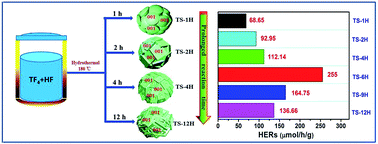 | Abstract: A facile in situ synthetic strategy has been developed to prepare highly active oxygen-deficient anatase TiO2 microsphere single crystals with modified {001} facets by simply controlling the hydrothermal reaction time. More importantly, on investigating the performance of photocatalytic hydrogen evolution, TiO2 microspheres consisting of micro-decahedrons with etched {001} facets show superior photoreactivity compared with TiO2 microspheres wrapped with intact-{001} faceted anatase crystals. As determined by electron spin resonance (ESR) measurement, short hydrothermal reaction time facilitates the formation of oxygen vacancies, whereas longer hydrothermal reaction time contributes to the decrease of oxygen vacancies and formation of subsurface Ti3+ defect states. Based on the PL emission spectra obtained at different excited wavelengths, a possible mechanism of charge separation and transport resulting from changing of bulk/ surface trapping sites on the building blocks of TiO2 microspheres is proposed, and the enhanced photocatalytic efficiency of the as-prepared TiO2 microsphere is largely attributed to the efficient separation and transport of photogenerated charge carriers caused by rational surface modulation and modification. KeyWords Plus: SELF-DOPED TIO2; VISIBLE-LIGHT; ANATASE TIO2; SINGLE-CRYSTALS; HYDROGEN-PRODUCTION; RUTILE TIO2; TITANIA; NANOSTRUCTURES; NANOPARTICLES; IRRADIATION Published in RSC ADVANCES, 7 (16):9902-9907; 10.1039/c6ra28533c 2017 |

